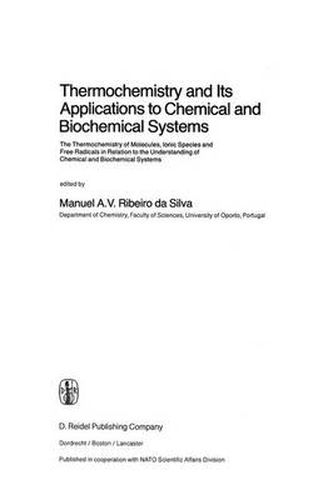Readings Newsletter
Become a Readings Member to make your shopping experience even easier.
Sign in or sign up for free!
You’re not far away from qualifying for FREE standard shipping within Australia
You’ve qualified for FREE standard shipping within Australia
The cart is loading…






This title is printed to order. This book may have been self-published. If so, we cannot guarantee the quality of the content. In the main most books will have gone through the editing process however some may not. We therefore suggest that you be aware of this before ordering this book. If in doubt check either the author or publisher’s details as we are unable to accept any returns unless they are faulty. Please contact us if you have any questions.
The progress that has recently been made in the field and applications of thermochemistry, having as a consequence an in- crease in the interest of the subject, undoubtedly can be con- sidered highly remarkable. Traditionally, the thermochemist has provided accurate ther- mal data on chemicaZ compounds of practicaZ importance, mainly by calorimetric and by equilibrium studies. The scope has been considerably extended in recent years, following the development of microcalorimetric techniques, of flow calorimetry, of titra- tion calorimetry, and of high temperature calorimetry. The im- pact has been most noticeable in biochemical studies, in metallur- gical studies, and in organometallic and inorganic thermochemis- try. A parallel development has led to increasing output of signi- ficant thermal data on gas-phase transient species (e.g. free ra- dicals, radical ions) by kineticists, and by use of photoioniza- tion spectroscopy, mass spectroscopy and ion-cyclotron resonance spectroscopy. These species are outside the scope of traditional calorimetric study, but as more data on them become available they vastly add to the value of traditional thermochemical data and enable bond energies to be evaluated, and the inter-relation of molecular structure and bonding energy to be more closely exa- mined.
$9.00 standard shipping within Australia
FREE standard shipping within Australia for orders over $100.00
Express & International shipping calculated at checkout
This title is printed to order. This book may have been self-published. If so, we cannot guarantee the quality of the content. In the main most books will have gone through the editing process however some may not. We therefore suggest that you be aware of this before ordering this book. If in doubt check either the author or publisher’s details as we are unable to accept any returns unless they are faulty. Please contact us if you have any questions.
The progress that has recently been made in the field and applications of thermochemistry, having as a consequence an in- crease in the interest of the subject, undoubtedly can be con- sidered highly remarkable. Traditionally, the thermochemist has provided accurate ther- mal data on chemicaZ compounds of practicaZ importance, mainly by calorimetric and by equilibrium studies. The scope has been considerably extended in recent years, following the development of microcalorimetric techniques, of flow calorimetry, of titra- tion calorimetry, and of high temperature calorimetry. The im- pact has been most noticeable in biochemical studies, in metallur- gical studies, and in organometallic and inorganic thermochemis- try. A parallel development has led to increasing output of signi- ficant thermal data on gas-phase transient species (e.g. free ra- dicals, radical ions) by kineticists, and by use of photoioniza- tion spectroscopy, mass spectroscopy and ion-cyclotron resonance spectroscopy. These species are outside the scope of traditional calorimetric study, but as more data on them become available they vastly add to the value of traditional thermochemical data and enable bond energies to be evaluated, and the inter-relation of molecular structure and bonding energy to be more closely exa- mined.